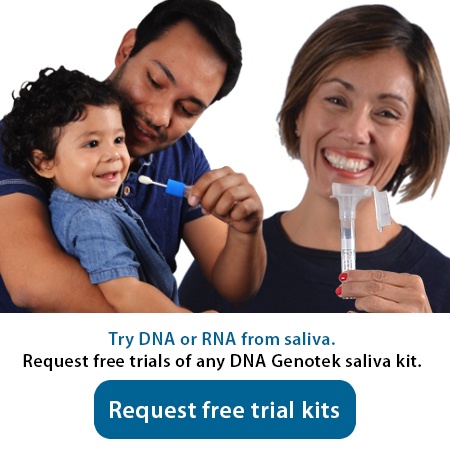2019-10-01
Around the world, genetic research continues to highlight new discoveries. Many of these discoveries are possible through the use of technologies that allow easy, non-invasive DNA collection in challenging environments while maintaining high quality samples. Through the use of combined collection and stabilization kits, such as Oragene® saliva kits, DNA can be collected, shipped and stored at ambient temperature making DNA collection feasible in any environmental condition. You’ll be amazed at the places we’ve gone…to collect saliva samples.
Brazilians, xeroderma pigmentosum, and sun exposure
Ultraviolet (UV) light from sun exposure can cause many problems. Individuals with a rare autosomal recessive disorder called Xeroderma pigmentosum (XP) experience high sensitivity to UV light from the sun. Patients with XP (who are under 20 years old) are 10x more likely to experience hypersensitivity to sunlight than the general population. A community in Brazil, with a significant number of individuals diagnosed with XP, are thought to contain a genetic cluster of this disorder Dr. Carlos Menck and his team from the University of Sao Paulo collected saliva (using Oragene·DNA) from 50 Brazilians in the field at temperatures close to 35 degrees Celsius. They then travelled with the samples back to the lab without cold storage. Once at the lab, they performed Sanger sequencing to identify mutations in the POLH gene (which is associated with XP). They found two different pathogenic mutations in the POLH which could be causing the XP disorder. The first mutation, on exon 8, is likely to have derived from the European colonization and the second mutation, on intron 6, is a novel mutation that needs further investigation.[1]
“The collection of saliva using the Oragene collection kit was easy and fast. The samples are quite stable in the field and while travelling back to the lab, even in high temperatures of that region (close to 35ºC). Furthermore, our analysis on paired Oragene/saliva and blood samples indicates no difference in DNA yield, quality and genotyping results.” Prof Dr. Carlos Menck
Origins of the Paleo-and Neo-Eskimo peoples in the Alaskan North Slope
Approximately 4,500 years ago, a group of terrestrial mammal hunters migrated east from Beringia to Greenland forming small settlements along the Alaskan and Canadian Coasts. These people, then known as the Paleo-Eskimos, occupied these regions for the next 3,000 years until a new economic culture evolved around whale hunting (about 750-800 YBP) by Neo-Eskimos that spread into the Paleo-Eskimo territories. All modern Inupiaq people in that area are known to share a common origin: the Paleo-and Neo-Eskimo people. Raff et al. surveyed mitochondrial diversity in remote Alaskan North Slope (the most northern region of Alaska) communities and some North American Arctic communities, where they collected DNA saliva samples in field using Oragene from 181 adults.[2]
In the Alaskan North Slope, temperatures year-round range from an average of 15ºC in the summer to sometimes even as cold as -40ºC [3], which can make sample collections in those remote regions rather challenging with temperature fluctuations.
From the mitochondrial data that they collected, they found lineages from the Alaskan North Slope through a variety of haplogroups (A2, A2a, A2b, D4bla, and D2a) that are consistent with the predictions that the Paleo and Neo-Eskimos’ migration starting point was the Alaskan North Slope and migrated further into Canada and Greenland. They also found some genetic continuity (haplogroup D2a) between Paleo-Eskimos and contemporary Inupiat peoples in this region.[2]
Visceral Leishmaniasis (VL) disease in India
Visceral Leishmaniasis (VL) is a severe disease caused by a parasite Leishmania donovani and after malaria, it is the second largest parasitic killer in the world. Dr. Shyam Sundar from Banaras Hindu University, was interested in studying the host genetic factors responsible for VL. His team collected samples from individuals in remote villages of Muzaffarpur, where the temperature averages from +22°C to +38°C (+72°F - +100°F). It was important to maintain sample stability and quality while transporting these samples back to the processing lab 300 km away at Banaras Hindu University, Varanasi. Their use of Oragene to collect and stabilize DNA at ambient temperature allowed the samples to arrive at the lab with no degradation of DNA. Their results in their GWAS study pointed out HLA class II a major genetic risk factor in Indian Visceral Leishmaniasis. [4]
“[Oragene] fulfilled [our] requirements for easy handling and transport for ensuring high quality DNA samples for use on a genome wide association array. Oragene/saliva samples are stable at ambient temperature for years (+15ºC - +50ºC) without demonstrating any sign of DNA degradation and are easily transported through standard mail.” Dr. Shyam Sundar.
Saliva collection around the world
The main challenge for most genetic field studies (often in remote areas with no clinical infrastructure) is obtaining stable, high quality DNA easily from target donors. When traveling to and from collection sites, temperature fluctuations will degrade DNA integrity if the sample is not stabilized properly – resulting in failed downstream analysis and the need to re-collect.
Oragene self-collection kits provide non-invasive, easy handling and transport, to ensure high quality DNA samples. Oragene/saliva samples are stable at ambient temperature for years (+15°C - +50°C) without demonstrating any sign of DNA degradation and are easily transported through standard mail.
DNA from saliva using Oragene can be collected from anywhere around the world, and you’d be amazed at the places you’ll go to collect saliva samples.
If you are interested in trying free samples of Oragene self-collection saliva kits for your own research project, click on the free kits request button or email info@dnagenotek.com.
References
[1] Munford V et al. A genetic cluster of patients with variant xeroderma pigmentosum with two different founder mutations. Brit J Dermatology. 176:1270-1278 (2017).
[2] Raff JA et al. Mitochondrial diversity of Inupiat people from the Alaskan North Slope provides evidence for the origins of the Paleo-and Neo-Eskimo peoples. Am J Physical Anthro.157:603-614 (2015).
[3] https://www.weatherbase.com/weather/weather-summary.php3?s=12305&cityname=North+Slope%2C+Alaska%2C+United+States+of+America&units=
[4] Case Study: Oragene®/saliva collection kit facilitates remote field collections for research project in India. https://www.dnagenotek.com/ROW/pdf/MK-00339.pdf


